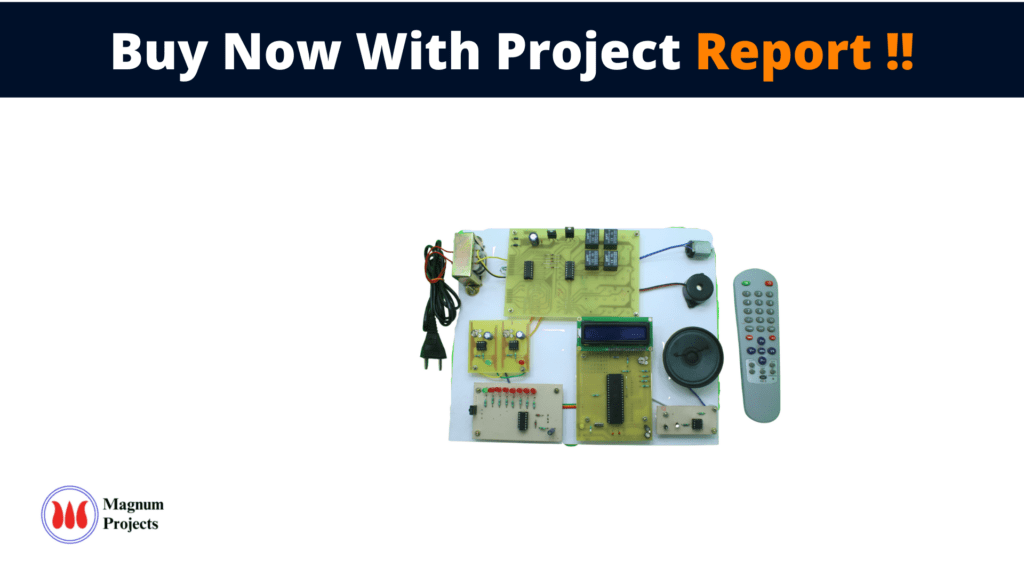Table of Contents
Introduction:

Tollgate Automation and Vehicle Tracking are designed to automatically keep track of the vehicle’s movement, record the time, and the details like the Owner’s name, date of registration, vehicle model, etc. This system is very useful for automatic vehicle tracking, time management, and also for automation of Toll gates. This paper explains the implementation of Toll Gate Automation which is a step towards improving the Tracking & monitoring of vehicles, traveling in predetermined routes. In this system, a computerized system automatically identifies an approaching vehicle and records the vehicle number & Time. If the vehicle belongs to the authorized person/group, it automatically opens the Toll Gate and a predetermined amount is automatically deducted from its account.
With the increase in the number of vehicles on the road, the task of traffic management becomes more complex. It is hard to keep & maintain the details of each vehicle, which is running on the road. Also in case of hit–and–run or carrying of illegal goods over inter-state cross-border or road-robbery cases, the police may not trace the culprits very easily, as the vehicle details are not monitored continuously. Suppose The Cargo Company wants to send a message to its On-road vehicle to stop delivering the goods to the customer, a policeman wants to stop a vehicle that is smuggling some illegal goods or city transports want to track each bus’s details such as departure and arrival time on bus terminal, number of round trips it has undergone in a single day. All this is possible by the use of automated toll gates. This system is intended to help the RTO, Police Department, Public Transport, and Cargo Companies to track the vehicles

Block diagram explanation
Power supply unit
This section needs two voltages viz., +12 V & +5 V, as working voltages. Hence specially designed power supply is constructed to get regulated power supplies.
IR transmitter and Receiver:
Infrared (IR) transmitters and receivers are present in many different devices, though they are most commonly found in consumer electronics. The way this technology works is that one component flashes an infrared light in a particular pattern, which another component can pick up and translate into an instruction. These transmitters and receivers are found in remote controls and all different types of devices, such as televisions and DVD players. Peripheral devices that include this technology can also allow a computer to control various other consumer electronics. Since infrared remotes are limited to line of sight operation.
Buffers
Buffers do not affect the logical state of a digital signal (i.e. a logic 1 input results in a logic 1 output whereas logic 0 input results in a logic 0 output). Buffers are normally used to provide extra current drive at the output but can also be used to regularize the logic present at an interface
Drivers
This section is used to drive the relay where the output is the complement of input which is applied to the drive but the current will be amplified
Relays
It is an electromagnetic device that is used to drive the load connected across the relay and the o/p of the relay can be connected to the controller or load for further processing.
Buzzer:
A buzzer or beeper is an audio signaling device, which may be mechanical, electromechanical, or piezoelectric. Typical uses of buzzers and beepers include alarm devices, timers, and confirmation of user input such as a mouse click or keystroke.
DC motor:
A DC motor relies on the fact that magnet poles repel and unlike magnetic poles attract each other. A coil of wire with a current running through it generates an electromagnetic field aligned with the center of the coil. By switching the current on or off in a coil its magnetic field can be switched on or off or by switching the direction of the current in the coil the direction of the generated magnetic field can be switched 180°.
Methodology:
This project is developed for tollgate automation. The main modules in this project are the IR transmitter and receiver, PIC decoder, Microcontroller unit, and output.
The IR transmitter will be there in a vehicle and the IR receiver and the remaining module will be there in a tollgate. When the vehicle comes near the tollgate, first it will check whether it is authorized or unauthorized. After authentication, if it is authorized then the person who is there in the vehicle has to press the buttons in the IR transmitter, then the IR receiver receives that signal and the PIC decoder decodes that signal, then based on the signal received the ARM controller will activate the output. If it is authorized it will open the gate or else it will activate the buzzer.
Advantages:
- This application is very useful in any place or area.
- Manpower can be saved.
- More reliable than a man.
- Enables very specific detection of vehicles.
- Automatic collection of toll tax
- Free flow of traffic.
- Time-saving.
- Record maintenance.
- Problems with pursuing toll evaders can be avoided.
Disadvantages:
- Low frequency results in a lower maximum data rate,
- Although it is fast enough to allow multiple transmissions to increase reliability.
- Tag usually requires power from the vehicle (active tag).
- Tag installation is not as convenient as that of a windshield-mounted tag.
- Moderate difficulty in duplicating tags.
Applications:
- This project and implementation is a very efficient tool for the automation of Toll Gate. It automatically identifies the vehicle and stores it in the record. Thus resulting in accuracy and efficiency.
- Since all the subscribed vehicles are detected well in advance and the gate is opened automatically, the drivers need not stop for Toll payments or even need not reduce their speed.
- The entire subscribed vehicle’s time is stored in the database. Even this can be used for theft and crime detection.
- This project and implementation can be used for other applications, like vehicle tracking, Timekeeping, Theft detection, etc…




